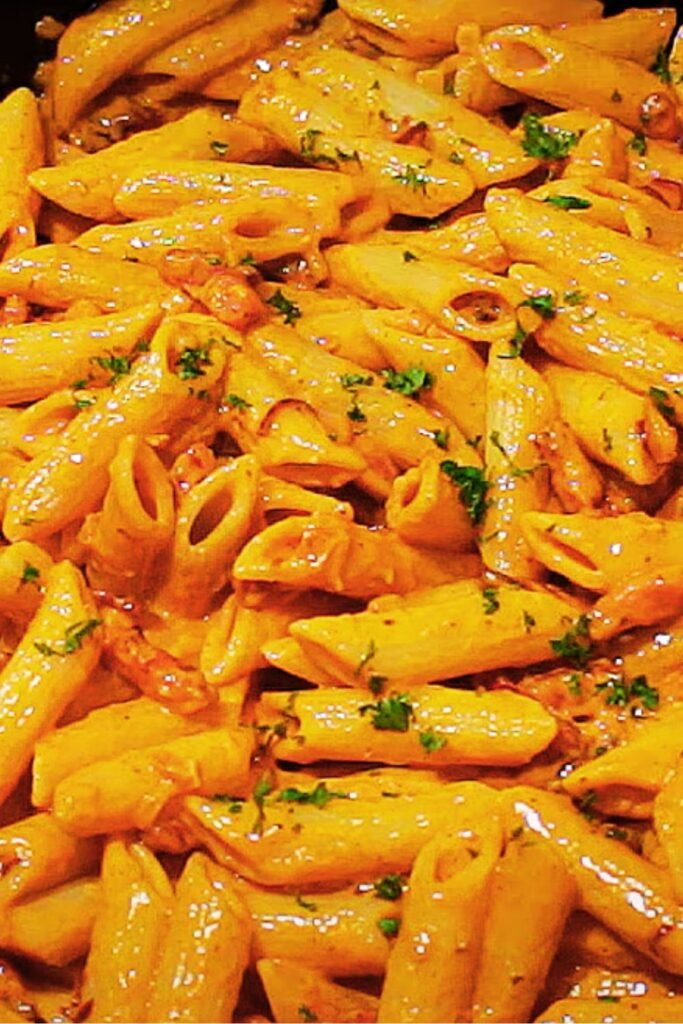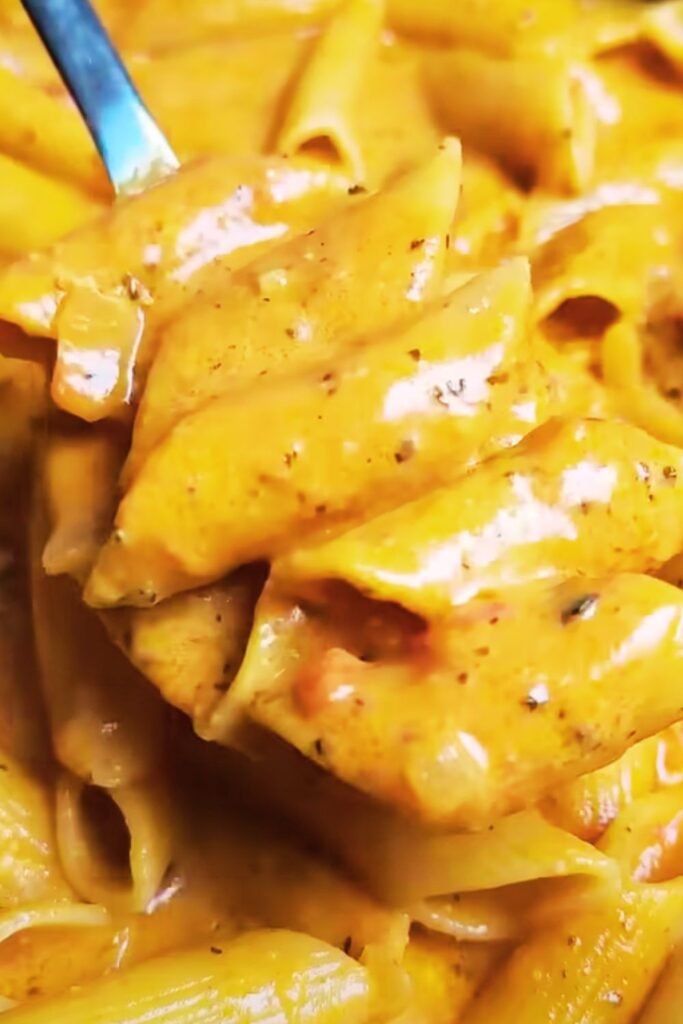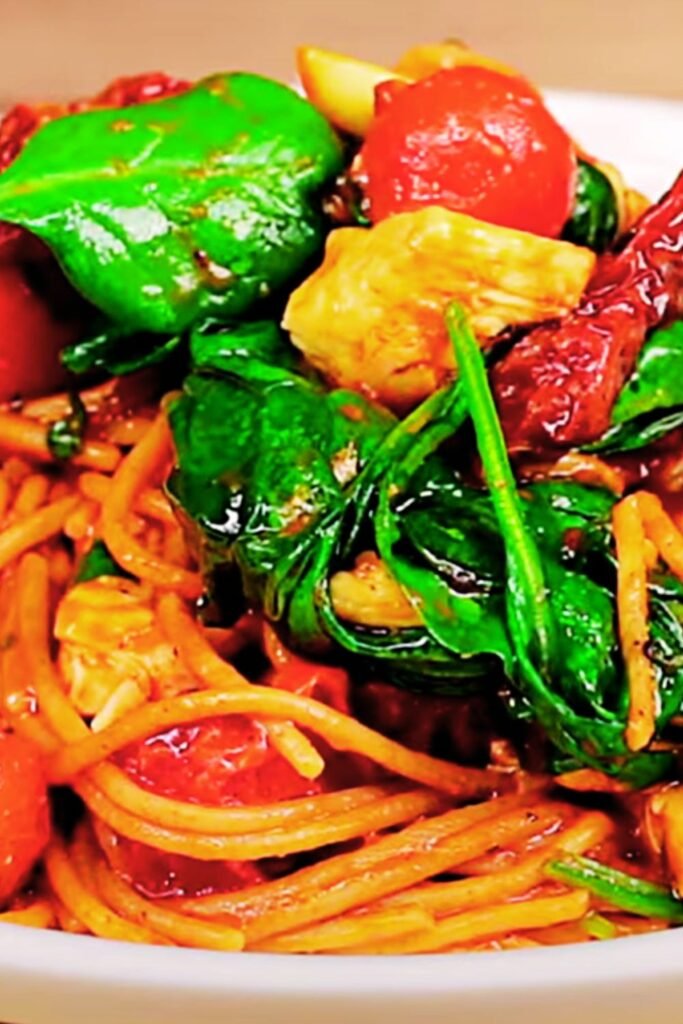I’ve been making this incredible chicken and bacon pasta dish for years, and I can honestly say it’s become one of my absolute favorite go-to meals. There’s something magical about the combination of tender chicken, crispy bacon, fresh spinach, and juicy tomatoes all brought together with aromatic garlic in a creamy sauce. This recipe has never failed to impress my family and friends, and I’m excited to share every detail with you.
When I first developed this recipe, I wanted to create something that balanced indulgence with nutrition. The result is a dish that satisfies those comfort food cravings while sneaking in plenty of vegetables and lean protein. The key to making this pasta extraordinary lies in the layering of flavors and the quality of ingredients you choose.
Understanding the Key Components
Chicken Selection: I always recommend using boneless, skinless chicken breasts or thighs for this recipe. Chicken thighs tend to stay more moist and flavorful, but breasts work beautifully too.
Bacon Choice: The bacon adds a smoky, salty depth that complements the other ingredients perfectly. I prefer thick-cut bacon for better texture and flavor distribution.
Spinach Benefits: Fresh spinach not only adds vibrant color but also provides essential nutrients like iron, vitamin K, and folate. It wilts beautifully into the sauce without overwhelming the dish.
Tomato Varieties: I use a combination of cherry tomatoes and sun-dried tomatoes for complexity. The cherry tomatoes burst with sweetness while the sun-dried ones add concentrated umami.
Garlic Power: Fresh garlic is non-negotiable in this recipe. It forms the aromatic foundation that ties all the flavors together.
Essential Ingredients and Their Roles
| Ingredient | Quantity | Purpose | Substitution Options |
|---|---|---|---|
| Chicken Breast | 1.5 lbs | Main protein | Chicken thighs, turkey breast |
| Thick-cut Bacon | 6-8 strips | Smoky flavor base | Pancetta, turkey bacon |
| Fresh Spinach | 4 cups | Nutritious greens | Baby kale, arugula |
| Cherry Tomatoes | 2 cups | Sweet acidity | Grape tomatoes, diced tomatoes |
| Garlic Cloves | 6 large | Aromatic foundation | Garlic powder (1 tsp) |
| Heavy Cream | 1 cup | Creamy sauce base | Half-and-half, coconut cream |
| Parmesan Cheese | 1 cup grated | Umami and richness | Pecorino Romano, Asiago |
| Pasta | 1 lb | Carbohydrate base | Penne, rigatoni, fettuccine |
| Olive Oil | 3 tbsp | Cooking fat | Avocado oil, butter |
| Italian Seasoning | 2 tsp | Herb blend | Fresh basil and oregano |
Step-by-Step Cooking Instructions
Preparation Phase
I always start by getting all my ingredients prepped and ready. This dish comes together quickly once you start cooking, so having everything chopped and measured makes the process smooth and enjoyable.
First, I slice the chicken into bite-sized pieces, about 1-inch cubes. This ensures even cooking and makes the dish easier to eat. Season the chicken generously with salt, pepper, and half of the Italian seasoning.
Next, I chop the bacon into small pieces – about ½-inch chunks work perfectly. The bacon will render its fat, which we’ll use to cook the chicken, so don’t worry about adding extra oil at this stage.
For the vegetables, I mince the garlic finely and halve the cherry tomatoes. The spinach can be left whole since it will wilt down significantly during cooking.

Cooking the Protein
I heat a large skillet or Dutch oven over medium-high heat and add the chopped bacon. The key here is to cook the bacon until it’s crispy but not burnt – usually about 5-7 minutes. The rendered fat should be golden and fragrant.
Once the bacon is crispy, I remove it with a slotted spoon and set it aside on a paper towel-lined plate. I leave about 2 tablespoons of bacon fat in the pan for cooking the chicken.
Now comes the chicken. I add the seasoned chicken pieces to the hot bacon fat and cook them without moving them for about 3-4 minutes. This creates a beautiful golden crust. Then I flip the pieces and cook for another 3-4 minutes until they’re golden on all sides and cooked through.
Building the Sauce
With the chicken cooked, I push it to one side of the pan and add the minced garlic to the empty space. I cook the garlic for just 30 seconds – any longer and it might burn and become bitter.
Next, I add the halved cherry tomatoes to the pan. They’ll start to soften and release their juices, which creates the base of our sauce. I cook them for about 2-3 minutes until they begin to break down slightly.

Now I pour in the heavy cream, stirring everything together. I bring this mixture to a gentle simmer – not a rolling boil, as that could cause the cream to separate. The sauce should be creamy and coat the back of a spoon.
Adding the Vegetables
Once the sauce is simmering gently, I add the fresh spinach in batches. Spinach wilts quickly, so I add half of it first, let it wilt, then add the remaining half. This prevents the pan from becoming overcrowded.
I return the crispy bacon to the pan and stir everything together. The colors at this stage are absolutely beautiful – the bright green spinach, red tomatoes, golden chicken, and creamy sauce create a feast for the eyes.
Pasta Preparation and Assembly
While I’m building the sauce, I cook the pasta according to the package directions in a large pot of salted water. I always cook it to al dente – it should have a slight bite to it since it will continue cooking slightly when mixed with the hot sauce.
Here’s a crucial tip I learned over the years: I reserve about 1 cup of the pasta cooking water before draining. This starchy water is liquid gold for adjusting the sauce consistency.
Once the pasta is drained, I add it directly to the skillet with the sauce. I toss everything together, adding the grated Parmesan cheese and the remaining Italian seasoning. If the sauce seems too thick, I add a splash of the reserved pasta water until it reaches the perfect consistency.

Flavor Enhancement Techniques
The Garlic Factor
Garlic is truly the star of this dish, and I’ve learned several techniques to maximize its impact. First, I always use fresh garlic rather than pre-minced or powdered. The oils in fresh garlic are more volatile and provide better flavor.
When mincing garlic, I use the flat side of my knife to crush each clove slightly before chopping. This releases more of the aromatic compounds. I also add the garlic at just the right moment – after the chicken is cooked but before the tomatoes, so it gets fragrant without burning.
Bacon Rendering Tips
The bacon fat is one of the secret weapons in this recipe. I cook the bacon slowly over medium heat rather than high heat. This allows the fat to render properly and gives the bacon a better texture. The rendered fat becomes our cooking medium for the chicken, adding layers of smoky flavor throughout the dish.
Cream Sauce Mastery
Creating a perfect cream sauce requires attention to temperature and timing. I never let the cream boil vigorously – a gentle simmer is all you need. If you accidentally let it boil, don’t panic. Just reduce the heat and whisk gently to bring it back together.
The key to a smooth sauce is gradual temperature changes. I let the cream come to room temperature before adding it to the hot pan, which helps prevent curdling.
Nutritional Information and Health Benefits
| Nutrient | Per Serving | Daily Value % |
|---|---|---|
| Calories | 685 | 34% |
| Protein | 42g | 84% |
| Carbohydrates | 58g | 19% |
| Fat | 32g | 49% |
| Fiber | 4g | 16% |
| Iron | 4.2mg | 23% |
| Calcium | 285mg | 28% |
| Vitamin A | 2,847 IU | 57% |
| Vitamin C | 24mg | 40% |
| Folate | 168mcg | 42% |
This dish provides an excellent balance of macronutrients. The chicken offers high-quality protein essential for muscle maintenance and growth. The spinach contributes significant amounts of iron, vitamin K, and folate, while the tomatoes provide vitamin C and lycopene, a powerful antioxidant.
Despite being indulgent, this recipe incorporates plenty of vegetables, making it a more balanced option than many pasta dishes. The combination of protein and complex carbohydrates helps maintain steady blood sugar levels.
Serving Suggestions and Presentation
I love serving this pasta family-style in a large, shallow bowl that showcases all the colorful ingredients. A sprinkle of fresh herbs like basil or parsley adds a pop of color and freshness that complements the rich flavors.
For sides, I often prepare a simple mixed green salad with a light vinaigrette to cut through the richness of the pasta. Garlic bread is always a hit, though it’s certainly not necessary given how satisfying this dish is on its own.
When entertaining, I like to serve this pasta with roasted vegetables like zucchini, bell peppers, or asparagus. The additional vegetables add color to the plate and provide different textures and flavors.
For portion control, I typically serve this as a main dish with about 1.5 cups per person. It’s rich enough that smaller portions are quite satisfying, especially when paired with a salad or vegetables.
Storage and Reheating Guidelines
This pasta stores beautifully in the refrigerator for up to 4 days. I transfer leftovers to airtight containers once they’ve cooled to room temperature. The sauce may thicken slightly in the refrigerator, which is completely normal.
When reheating, I prefer using the stovetop method over the microwave. I add a splash of milk or cream to the pan along with the pasta and heat it gently over medium-low heat, stirring frequently. This method helps restore the creamy texture of the sauce.
If you’re planning to make this dish ahead of time, I recommend slightly undercooking the pasta initially. This prevents it from becoming mushy when reheated. You can also prepare the sauce separately and combine it with freshly cooked pasta when ready to serve.
Recipe Variations and Customizations
Vegetable Additions
Over the years, I’ve experimented with various vegetable additions to this base recipe. Mushrooms work wonderfully – I sauté them along with the garlic for earthy depth. Bell peppers add sweetness and crunch, while zucchini provides additional nutrition without overwhelming the dish.
Sun-dried tomatoes can be added alongside the fresh tomatoes for more concentrated tomato flavor. I usually chop them roughly and add them when I add the cherry tomatoes.
Protein Variations
While chicken and bacon are classic, I’ve successfully made this dish with other proteins. Turkey works well as a substitute for chicken, and prosciutto can replace bacon for a more delicate flavor. For a pescatarian version, I’ve used salmon or shrimp instead of chicken, though I keep the bacon for its essential smoky flavor.
Cheese Options
Parmesan is my go-to cheese for this recipe, but I’ve experimented with others. Pecorino Romano adds a sharper, saltier flavor, while Asiago provides a nuttier taste. For a more indulgent version, I sometimes add a small amount of cream cheese to make the sauce even richer.
Herb Variations
Fresh herbs can transform this dish. I love adding fresh basil at the end for brightness, or fresh thyme during cooking for earthiness. Oregano works well too, especially if you’re going for a more Mediterranean flavor profile.
Common Mistakes and How to Avoid Them
Overcooking the Garlic
One of the most common mistakes I see is burning the garlic. Garlic goes from fragrant to bitter very quickly, so I always add it after the chicken is cooked and watch it carefully. If you accidentally burn it, it’s better to start over than to continue with bitter garlic.
Cream Sauce Separation
If your cream sauce separates or curdles, it’s usually because the temperature was too high or the cream was too cold when added. To prevent this, I always bring cream to room temperature before adding it to the hot pan, and I keep the heat at medium or below.
Overcooked Pasta
Pasta continues to cook when mixed with the hot sauce, so I always cook it to al dente. If you cook it until it’s completely tender in the boiling water, it will be mushy by the time you serve it.
Underseasoned Dish
This recipe has many components, and each needs proper seasoning. I season the chicken before cooking, taste the sauce before adding the pasta, and always finish with a final seasoning adjustment.
Questions and Answers
Q: Can I make this recipe with whole wheat pasta? A: Absolutely! Whole wheat pasta works beautifully in this recipe. It adds extra fiber and nutrients while providing a slightly nuttier flavor that complements the other ingredients well.
Q: How can I make this dish lighter without sacrificing flavor? A: I’ve made several lighter versions of this recipe. You can substitute half-and-half for heavy cream, use turkey bacon instead of regular bacon, and add extra vegetables like zucchini or bell peppers to increase volume without adding calories.
Q: What’s the best way to reheat leftovers? A: I always reheat on the stovetop over medium-low heat with a splash of milk or cream. This method helps restore the creamy texture better than microwaving, which can make the sauce grainy.
Q: Can I freeze this pasta dish? A: While you can freeze it, I don’t recommend it because cream-based sauces can separate when thawed. If you do freeze it, reheat it very gently and be prepared to add some fresh cream to restore the texture.
Q: What pasta shapes work best for this recipe? A: I prefer pasta shapes that hold sauce well, like penne, rigatoni, or shells. Fettuccine also works beautifully if you prefer long pasta. The key is choosing something that will capture and hold the creamy sauce.
Q: How do I know when the chicken is properly cooked? A: The chicken should reach an internal temperature of 165°F (74°C) and should be golden brown on the outside. Cut into a piece to check – it should be white throughout with no pink areas.
Q: Can I use frozen spinach instead of fresh? A: You can, but fresh spinach is definitely preferable. If using frozen, thaw it completely and squeeze out excess water before adding it to the pan. Use about 1 cup of frozen spinach instead of 4 cups fresh.
Q: What wine pairs well with this dish? A: While I don’t include alcohol in my cooking suggestions, many people enjoy this pasta with a crisp white wine like Pinot Grigio or Sauvignon Blanc, or a light red like Pinot Noir.
Q: How can I make this recipe dairy-free? A: You can substitute the heavy cream with coconut cream and use nutritional yeast instead of Parmesan cheese. The flavor will be different but still delicious.
Q: Is there a way to add more vegetables without changing the character of the dish? A: Definitely! I often add diced bell peppers with the tomatoes, or mushrooms with the garlic. Zucchini and yellow squash also work well. Just be sure to cook them until tender before adding the cream.
This chicken and bacon pasta with spinach and tomatoes in garlic has become one of my signature dishes, and I hope it becomes a favorite in your kitchen too. The combination of flavors and textures creates a truly satisfying meal that works for both casual family dinners and special occasions. Remember, the key to great cooking is tasting as you go and adjusting seasonings to your preference. Each time you make this recipe, you’ll discover little ways to make it even better suited to your taste.